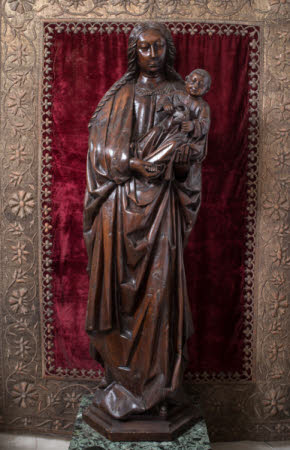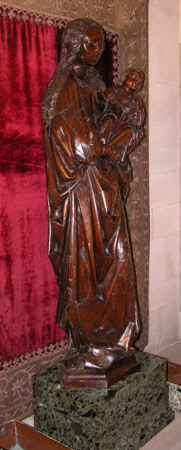Virgin and Child
Southern Netherlands
Category
Art / Sculpture
Date
c. 1450 - 1460
Materials
Walnut
Measurements
345 x 573 x 438 mm
Place of origin
Brabant (Belgium)
Order this imageCollection
Anglesey Abbey, Cambridgeshire
NT 514398
Summary
Wood; Virgin and Child; Southern Netherlands (Flemish); c. 1450-60. A large and impressive wooden sculpture of the Virgin and Child, with the richly-robed Virgin holding the Christ Child, who has in his hands a small bird, on an integral hexagonal base. Made in the Southern Netherlands around the middle of the fifteenth century.
Full description
A full-size wooden sculpture of the Virgin and Child, depicting the Virgin standing, richly robed, cradling in her hands the Christ Child, who holds a small bird. On an integral hexagonal base, now mounted on a modern wooden hexagonal mount, in turn standing on a green verde antico marble base. The sculpture gives the appearance of having been constructed in sections. The back is carefully hollowed out, with a tongue along the edges of the sides of the cavity suggesting that there was once a back piece made to conceal the cavity. The painted number ‘180’ at front. This monumental sculpture of the Virgin and Child is likely to have been made in Flanders (modern Belgium) around the middle of the fifteenth century or a little later, perhaps in the Hainault region to the south- west of Brussels. Like many Late Gothic figure sculptures from the southern Netherlands, the Anglesey Abbey Virgin and Child bears witness to the close stylistic ties between painting and sculpture at this time, in particular the work of Robert Campin (1378/79 – 1444) and Rogier van der Weyden (c. 1399-1464), in for example the handling of the complex drapery folds. The face of the Virgin, with her high-arched brows, high domed forehead and small, puckered lips, may be compared with a standing figure of the Virgin and Child in the church of Saint-Quentin in Wodecq, to the west of Brussels (John W. Steyaert, Late Gothic Sculpture. The Burgundian Netherlands, exh. cat., Museum voor Schone Kunsten, Ghent, 1994, pp. 106-07, no. 7). The sculpture also compares well with a similarly hieratic large walnut Virgin and Child, attributed to the Southern Netherlands and dated c. 1450-1500, with the Galerie Sismann, Paris in 2019 (Galerie Sismann. Sculpture Européenne/European Sculpture 1000-1800, Paris 2019, no. 6, height 100 cm.). The Virgin’s ovoid face, high hairline and hair carefully curled away from the head are all similar, as is the slightly plump and clumsy Christ Child. An even closer figure of Christ is in an alabaster statuette of the Virgin and Child in the Saint Louis Art Museum, dated c. 1460 (Inv. 12:1922). Jeremy Warren November 2021
Provenance
Urban Huttleston Rogers Broughton, 1st Lord Fairhaven (1896-1966); acquired by 1940; Anglesey Abbey inventory 1940, p. 27, Entrance Hall, valued at £60; bequeathed in 1966.
Marks and inscriptions
Bottom, front left: ‘180’ in white paint, on draperies.
Makers and roles
Southern Netherlands , sculptor
References
'Anglesey Abbey, Lode, Cambridgeshire. An Inventory and Valuation of Furniture, Books, Ornamental Items & Household Effects .. prepared for Insurance Purposes’, Turner, Lord and Ransom, April 1940, p. 27. Christie, Manson & Woods 1971: The National Trust, Anglesey Abbey, Cambridge. Inventory: Furniture, Textiles, Porcelain, Bronzes, Sculpture and Garden Ornaments’, 1971, p. 142.




